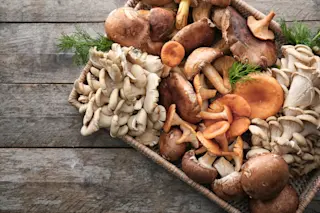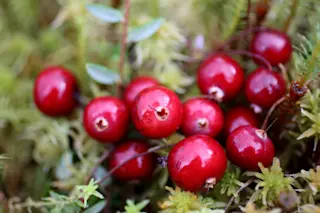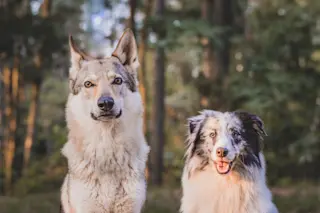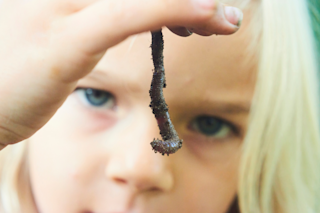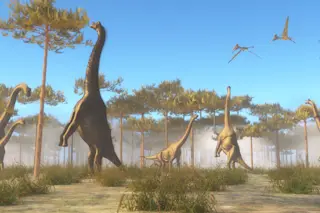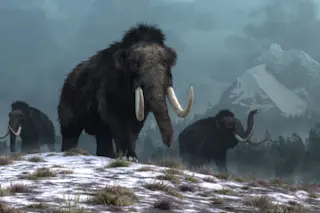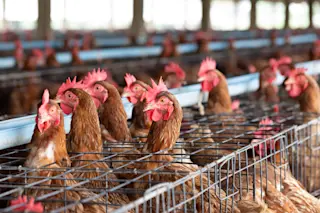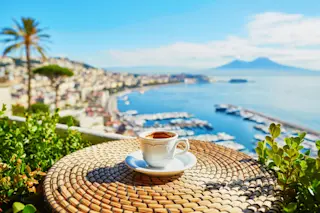Every morning for three months of the year, Lola wakes at 8 and goes hunting. She races past oak trees, running at full speed through a 50-hectare field set in the southern end of the province of Buenos Aires, Argentina. The daily challenge — to find her elusive prey — never fails to excite Lola. She darts from place to place until faltering at last: 40 minutes into her day, she gets distracted or simply gives in to exhaustion.
Lola is a Brittany spaniel, and beneath her orange-spotted white coat is the agile body of a hunter. But her most important tool is her sense of smell. “Through training, dogs learn to recognize substances in their long-term memory — in this case, the smell of truffles,” says dog trainer Germán Escobar.
A graduate of the University of Buenos Aires who originally hails from Colombia, Escobar has trained Lola and the eight other dogs of the Argentine truffle farm Trufas del Nuevo Mundo, located in Espartillar, a small town of 785 inhabitants.
With 100 million to 300 million olfactory receptors in the nose — humans have only 5 million to 6 million — and a region in their brains dedicated to odor analysis that’s 40 times larger than that of Homo sapiens, trained dogs are able to do what no human can: Track one of the most valuable and desired delicacies, what’s called the “black diamond” of the kitchen, deep underground.
For centuries, truffles were found exclusively in European countries such as Spain, Italy and France, where they grow in the wild. But over the past 50 years, truffle production has experienced an incredible global expansion, thanks to cultivation techniques that have given rise to plantations in far-flung regions. Today, the United States, China, Greece and Turkey as well as countries across the Southern Hemisphere — Australia, New Zealand, South Africa, Chile and Argentina — have emerged as new producers of the famous fungi.
At least 180 species of truffle are known, although only about 13 are of any commercial interest: the black truffle (Tuber melanosporum, from the Latin tubera, meaning lump, hump or swelling) is one of the most celebrated and coveted. In July 2022, a kilo of black truffles went for 1,350 euros. Another highly valued species is the white truffle (Tuber magnatum), also known as Trifola d'Alba Madonna (Truffle of the White Virgin), for which festivals are organized in Italy every year.
World truffle production has grown in recent years thanks to the increase in cultivation of this prized fungus, says a 2021 analysis published in the journal Forests. Spain leads world production of black truffles, with an annual average of 47 tons, followed by France and Italy.
The scent of truffles
Each of these natural jewels — black, rough, spherical, some as big as apples — is a miniature aroma factory. Some say that the black truffle smells like cold mountain air, or damp earth. Others say it evokes the smell of boiled potato, cauliflower, black olive, butter, mushroom, sulfur or garlic.
In 1825, the French gastronome Jean Anthelme Brillat-Savarin crowned it as “the jewel of the kitchen” and highlighted it as an aphrodisiac. Italian composer Gioachino Rossini went further and declared this mushroom the “Mozart of mushrooms.” And it was said that the English poet Lord Byron used to keep a truffle on his desk, confident that its perfume would stimulate creativity and attract the muses.

(Credit: TRUFAS DEL NUEVO MUNDO S.A. 2021/Knowable Magazine) Trained dogs, like Lola, are able to identify truffles growing underground thanks to their powerful sense of smell.
TRUFAS DEL NUEVO MUNDO S.A. 2021/Knowable Magazine
The truffle’s unique aroma is the result of a set of volatile organic compounds (VOCs) produced by the fungus. Far from being the result of a single molecule, the odors we perceive are produced by tens or hundreds of these invisible airborne particles. The structure of each VOC molecule is usually based on a hydrocarbon skeleton, with oxygen, nitrogen and sulfur as the most common atoms other than carbon or hydrogen; the molecules are all around us, and those that are generated by living organisms directly or indirectly influence the life of plants, insects and even humans by contributing to communication, mating and even the generation of flavors and aromas. For example, the smell of coffee is produced by at least a thousand chemical compounds that enter through our nostrils and meet our olfactory receptors. In strawberries, the number is more than 300 VOCs.
Of all fungi, truffles are among those that emit the highest amount of volatile organic compounds. More than 200 of these have been identified so far in various truffle species. Both black and white truffles pump out a mixture of alcohols, ketones, aldehydes, dimethyl sulfide, dimethyl disulfide, diacetyl, ethylphenol, furaneol and octenol.
“The aroma potency varies according to truffle type,” wrote Italian chemist Elisabetta Torregiani and her team at the University of Camerino in a paper published in 2020 in the journal Molecules. “Black truffles are considered to be the most aromatic of all,” while summer truffles are the least, and white truffles are in the middle.
In addition, “the truffle’s aroma changes throughout its maturation,” says researcher Eva Tejedor Calvo, from the Center for Agricultural and Food Research and Technology of Aragon, in Zaragoza, Spain. Tejedor Calvo traveled to Argentina to study the aromatic differences between black truffles from that South American country and Spanish truffles. “We know that, depending on the locations within the same country, the aromas can change. They can also vary depending on the climate, depending on the soil, even between two trees in the same field.”
The aromatic potency of these fungi, which grow between 20 and 50 centimeters underground in complete darkness and attached to tree roots, serves a purpose. It is an evolutionary strategy for their survival as a species.
“Fungi are so smelly because they communicate chemically with other organisms in their environment,” explains Joan W. Bennett, a microbiologist at Rutgers University and coauthor of a report on aromatic diversity in the fungal kingdom in the 2020 Annual Review of Microbiology. “Fungi do not have nervous systems, so they must use other means of defense and dispersal. For example, some of the volatile compounds attract insects that clearly help with the dispersal of their spores. While hundreds of VOCs associated with molds and fungi have been chemically identified, we are only now beginning to understand their functionality.”
“Their delicious aroma and nutritional power attracts animals that benefit from eating them, and they carry them in their intestines and thus disperse them in faraway places,” explains Argentine mycologist Francisco Kuhar, a researcher at the Multidisciplinary Institute of Plant Biology of the National Scientific and Technical Research Council of Argentina, and coauthor of the book Crónicas del Reino de los Hongos (Chronicles of the Kingdom of Mushrooms). “We can say that their exquisite aroma was selected to use us animals to disperse them.”
This sophisticated strategy of olfactory manipulation extends throughout all members of the mushroom family. In the case of truffles, they use it in a similar way as that developed by flowers that rely on insects and birds as dispersers and pollinators. “Unlike most fungi that spread their spores through the air, truffles are found underground and require animals to help with their dispersal,” says Bennett. “It is believed that the truffle odor evolved because volatiles can diffuse through the soil and attracts animals to eat and further disseminate their spores. This production of pungent cocktails consisting of volatile compounds draws a set of small animals that truffles have coevolved with, or at least adapted to, in order to facilitate spore dispersal.”
Pigs are one of these animals. Since the 15th century, black truffle hunters in Italy and France made use of trained pigs, especially females, which were particularly attracted to the intoxicating smell of the truffle that emanates a compound chemically similar to androstenol, a sex pheromone that is also synthesized in the testicles of wild boars.
The problem is these animals are not only mesmerized by the truffle’s aroma but also by its taste, and it is very difficult to train them not to devour it. For this reason, truffle pigs were banned in Italy in 1985. There, professional truffle hunters (known as tartufai) must be licensed. They roam the fields with trained dogs and their knowledge, which has been passed down orally for centuries, is included in UNESCO’s Representative List of the Intangible Cultural Heritage of Humanity.
From wild to cultivated
In the early 1880s, the King of Prussia asked the forest biologist Albert Bernhard Frank to study truffles. Wilhelm I adored the fungus’s delicate flavor and wanted the researcher to develop a way to produce truffles on a commercial scale.
But Frank failed in attempt after attempt, as did all the other enthusiasts who followed him. Still, the dedicated and meticulous botanist’s many years of study were not in vain, as plant ecologist David W. Wolfe recalls in his book Tales from the Underground: A Natural History of Subterranean Life: Frank noticed that truffles never grew independently, but always appeared near oak, hazel, poplar and beech trees. He surmised that the truffle was a parasite. Later he figured out that the two organisms work in partnership. Trees depend on fungi to help gather essential minerals, and truffles, which cannot photosynthesize, receive nutrients from the tree’s roots. In 1885, Frank described this symbiotic relationship with the term “mycorrhiza” (from the Greek myco, meaning fungus, and rhiza, meaning root).
Since then, intimate associations between plants and fungi have been identified in fossils dating back more than 450 million years. Today, more than 200,000 plant species are known to harbor mycorrhizal fungi.
“Mycorrhizal fungi extend the plant root systems and these fungi ‘forage’ the soil for nutrients, especially nitrogen and phosphorus. They can also confer drought and pathogen resistance,” notes University of New Hampshire ecologist Serita D. Frey, who describes this symbiotic link in a paper published in the 2019 Annual Review of Ecology, Evolution, and Systematics. “In exchange for these vital services, the plant provides the fungus with energy in the form of sugars which the plant makes through photosynthesis.” And she adds that some plants cannot survive without their fungal partner. “They have become dependent on the fungi for nutrition.”
In his book Truffle Hound: On the Trail of the World’s Most Seductive Scent, with Dreamers, Schemers, and Some Extraordinary Dogs, Rowan Jacobsen points out that truffle cultivation remains as much an art as a science. Each farm follows its own techniques, some closely guarded secrets. The truffle’s journey from spore to plate is fraught with biological uncertainty, economic competition and logistical headaches.
Hundreds of conditions and variables must align: This finicky fungus grows only when environmental conditions (temperature range, well-marked seasons, rainfall or controlled irrigation) and soil conditions (acidity, humidity, minerals such as phosphorus and potassium) are exactly right.
Truffles were harvested from the wild until new inoculation techniques developed in France in the 1970s opened the door to growing the species in managed plantations. “In a nursery, it’s first a matter of attaching the fungus spore to the roots of the tree,” explains Faustino Terradas, sales manager of Trufas del Nuevo Mundo. “The spore then begins to germinate and generate a mycelium, or a fungus root, that is going to cover the root of the tree. Then it is taken to the field and planted.”
During the first few years, the tree’s health is cared for, the acidity of the soil is controlled, and water is supplied through irrigation in order to generate the conditions for the underground development of the truffle. “During the spring, the primordia or small truffles, red on the outside and white on the inside, are generated,” adds Terradas. “From then on, it matures. In autumn it widens. And in the winter is when it finishes ripening.”
Yields in France have fallen dramatically for more than a century — first, because of the closures of truffle fields during the World Wars, and then because of decreasing rainfall and rising temperatures.
This situation has boosted the truffle’s expansion. Truffles now inhabit continents where they were not found a hundred years ago. In recent decades, attempts to domesticate them have spread around the world: After centuries of being a delicacy exclusive to Europe and being dispersed by dogs, pigs, squirrels and insects, it is now humans, motivated by their special aroma, who are driving their planetary migration.
The first US black truffle was harvested in Northern California in 1987. In 2009, Chile became the third country in the Southern Hemisphere to cultivate truffles, after New Zealand and Australia. According to mycologist Ian Hall of the Royal Society of New Zealand, who developed methods for the first truffle plantations in the Southern Hemisphere, there may be as many as 1,000 truffle farms outside of Europe.
In Argentina, where harvesting takes place in the colder months of June, July and August, Trufas del Nuevo Mundo got its first “black diamond” — weighing in at 69 grams — in 2016. Since then, this venture has expanded to 20,117 mycorrhizal trees and exports truffles to the Northern Hemisphere when they are out of season in Europe.
The truffle “has a lot of history, but there is little research,” says Terradas. “Wheat has been planted for more than 4,000 years, but the truffle only 50 years ago. We still have a long way to go to understand the truffle and its development.”
10.1146/knowable-101222-2
Federico Kukso is a freelance science journalist based in Buenos Aires, Argentina. In 2015-16, he was a Knight Science Journalism Fellow at MIT. He is the author of Odorama: Historia Cultural del Olor and Dinosaurios del Fin del Mundo. This article originally appeared in Knowable Magazine, an independent journalistic endeavor from Annual Reviews.




